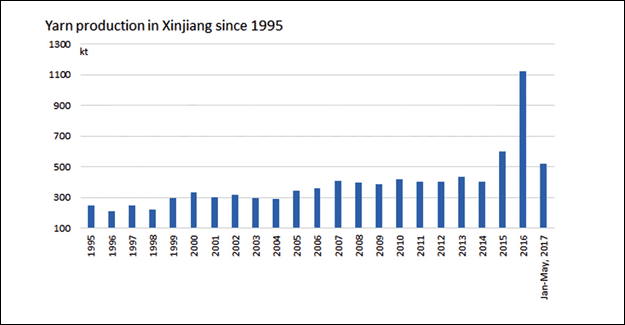
Xinjiang Spinning Status Quo And Cost Comparison
Yarn production continues to grow in Xinjiang
Yarn production is growing rapidly in Xinjiang, mainly for consumption by the inland market. Spinning capacity was only around 7 million spindles in 2014 but soared to 13.60 million spindles by end-2016, and the target at 20 million spindles by 2020 may be realised in advance, based on current progress of projects there.
Yarn production averaged at 280kt in 1995-2005, at 400kt in 2006-2014, surged rapidly in 2015-2016 and stayed at 1,120kt in 2016. Yarn output amounted to 517.8kt in Jan-May, 2017, up 58% y-o-y and sharing 46.2% of national production total. Industrial concentration ratio gradually improved in Xinjiang, and the following is the spinning capacity in some key regions:
Spinning capacity increased rapidly in Xinjiang, but local consumption capability is limited, mainly delivered to inland China for consumption. Export of textiles in Xinjiang remained small in the past two years despite promotion of The Belt and Road policy, only increasing slightly. Yarn export totaled 6kt in 2016 in Xinjiang, slanting low compared with the 1120kt of production, and above 80% was delivered to inland China.
Impact of Xinjiang-origin cotton yarn to inland and imported cotton yarn
Xinjiang-origin cotton yarn compares competitively with cotton yarn produced in inland China benefitting from advantage in policy and feedstock. Xinjiang-based spinners did not enjoy advantage in labour cost, but the competitiveness of electricity cost was apparent. The electricity cost for carded 32S in Xinjiang was around 1,000 yuan/mt lower than that in inland China, so spinners in Xinjiang had bigger profit margin. Xinjiang-origin cotton yarn 32S and 40S was mainly sold to Guangdong and Zhejiang, and the products focussed on medium-to-high end ones, with selling price flatting with that in inland. But the delivery time of Xinjiang-origin cotton yarn was longer.
It was learnt that some weavers and traders in inland have started co-operating with Xinjiang-based spinners, which snatched partial market share of cotton yarn in the inland. As for profit, theoretical margins of carded 32S was around 1,000-1,500yuan/mt in Xinjiang (including subsidies), while spinners in inland only witnessed meager margins now.
All in all, yarn production is anticipated to grow rapidly in Xinjiang in the future. With improvement of downstream supporting equipment, local consumption capability is supposed to increase, but it is a long-term process. Consumption of Xinjiang-origin yarn will still largely depend on inland market in recent years. The impact to spinners in the inland is more direct, and industrial upgrade of spinners there needs acceleration.
Textile Excellence
If you wish to Subscribe to Textile Excellence Print Edition, kindly fill in the below form and we shall get back to you with details.








